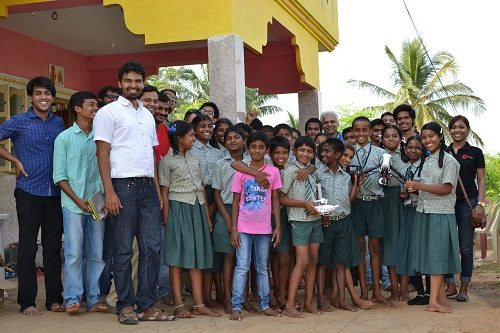In an era where kids are turning to playstations, rock bands and fashion, students at the Banjarapalaya Makerspace are creating their own entertainment in a different way. “Copper tapes, glue guns and analogue circuits welcomed us, with happy children creating wonders from them” says Rishi Bhatnagar, Accelerator Division, Target, as he talks about his experience on a visit to the makerspace.
Makerspaces, also called hackerspaces, hackspaces, or fablabs, are creative, do-it-yourself (DIY) spaces where people gather to create, invent and learn. DIY culture is an integral tool for learning at the Banjarapallaya Makerspace, which was founded by Abhijit Sinha.
 ‘Education 4 Development’ is an initiative by Abhijit Sinha and his team, which focuses on learning by actually building things. The team is developing low-resource, alternative education spaces in rural and under-served parts of India. They leverage massive open online courses (MOOCs) as learning resources to help students choose a learning path, based on their interest and curiosity.
‘Education 4 Development’ is an initiative by Abhijit Sinha and his team, which focuses on learning by actually building things. The team is developing low-resource, alternative education spaces in rural and under-served parts of India. They leverage massive open online courses (MOOCs) as learning resources to help students choose a learning path, based on their interest and curiosity.
The space is located near the Sri Sri Ravi Shankar Ashram, on the outskirts of Bangalore. As you enter, the village welcomes you with lush green fields and beautiful landscapes. Located on the ground-floor of a house, one cannot miss the warmth of the two dogs that greet you. The moment you step foot into the makerspace, you will be blown away watching children of all age groups glued to laptops and instructables; Arvindguptatoys.com seemingly their favorite website. They build their own things and you can find electronic components, Arduinos, analogue circuits and circuit stickers made from copper tape, strewn around the place. I had the opportunity to watch how people use simple electronics in the most creative ways possible. The interesting part is that the students do not stop just there. Electronics to us, toys to them, the young minds add their own touch of innovation to the toys and even write instructables to make sure their innovation reaches out to a larger audience. In fact, there is an entire wall filled with instructions to make a vegetable cutter. The kids actually made one and it works like a charm.
Already beautified by children running around, the walls around the place are decorated with beautiful drawings and illustrations. The dining area of this house-converted makerspace has a table full of unique projects, ranging from a mobile-controlled boat, which peddles and navigates through water, to musical instruments made from paper cups and decorative water bottles. Some of them visit the makerspace after school and a few even come from nearby villages. The entire space is built by the children, the way they want it. The tool room has a tool wall, which comprises all the basic tools one might need, from safety goggles to wire cutters, hammers, soldering irons and saws. There are containers full of old radios, printers and metal pieces. Although modern machines like three dimensional (3D) printers and laser-cutters are missing, it definitely seems like they do not miss them at all. It is also interesting that there is no gender bias. They all work together, solving problems and building solutions as one strong entity.
There were two things that I admired the most. One was how all the students were taking ownership of the space, tools, ideas and projects. The other was that the space was a budding, sustainable ecosystem. Abhijit Sinha, the founder of the space, is not required to be around all the time to manage things, as the students take care of everything themselves. He has been doing this successfully for more than a few months now.
I went there together with the Target Accelerator team and a few startups from the Target Accelerator Program. It was a get-together like no other. The team interacted with the children, asking them what their motivation was, to build projects. The young innovators were all keen to explain the real problems they were trying to solve using scientific concepts.
As part of events planned, Pixotica showcased their drones at the gathering. The children were excited on hearing that drones would be flying around. Manoj Varma, the founder of Pixotica, gave a brief introduction on how drones work. The moment the drones took off, the children could not stop cheering, and went around exploring their makerspace using the drone controllers. Having heard a short explanation earlier, the students were asked to share what they had understood about it. Though a little shy at the beginning, they soon started to explain the concepts demonstrating an impeccable understanding about drones. I could see a sense of pride on their faces. Pavan Kumar, the founder of Workbench Projects, pushed their imagination further by sharing new and innovative ideas with them.

I had never before seen this kind of innovation. It truly was a humbling and inspiring experience. I would recommend that everyone visit the makerspace and spend time with the children. They can definitely help find solutions for all the problems in the world. All they need in this space is a problem to solve.








